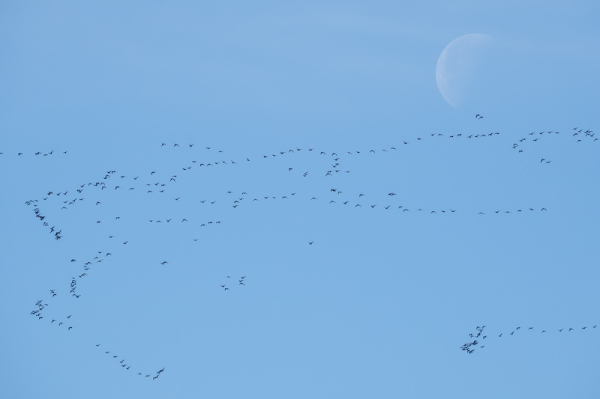
Barnacle geese at Sääperi in Tohmajärvi on Tuesday 20 May 2025. Photo: Jari Kontiokorpi / North Karelia ELY Centre.
- Previous Article Bank of Finland warns financial system risks are increasing
- Next Article Finns Party MPs failed to declare Philip Morris-funded trip
The main migration of barnacle geese into and through Finland began on Monday 19 May, according to the Centre for Economic Development, Transport and the Environment (ELY Centre).
On Tuesday 20 May, observers recorded 278,000 migrating barnacle geese at Söderskär in Porvoo and 252,000 more in Uukuniemi, Parikkala. The counts represent a significant portion of the population that winters around the North Sea and migrates annually to the Barents Sea region for breeding.
Before the main wave, an estimated 400,000 barnacle geese had gathered in North Karelia. Several thousand birds began moving during the previous weekend, with the largest single count of 49,200 at Puruvesi in Savonlinna on Saturday 17 May. Most of these geese landed in North Karelia and did not progress further until conditions changed.
Favourable wind conditions from the southwest on Monday triggered a coordinated departure from rest areas across Finland, including groups previously located in the Netherlands, Germany, Denmark and Estonia. Observers noted overnight migration activity, with birds arriving in southern Finland by early morning on Tuesday.
Mass movement continued throughout Tuesday, with heavy migration observed along the Gulf of Finland coastline and across southeast and eastern Finland. In over ten locations, daily counts exceeded 100,000 birds, with several breaking the 200,000 mark.
Rain from the northwest reached Finland on Tuesday afternoon, pushing the main flight corridor eastward and prompting many geese to land in North Karelia. At Sääperi in Tohmajärvi, observers recorded 105,000 migrating barnacle geese. Around 4,000 birds stopped to feed or rest during the day.
Weather patterns have largely supported migration this year. According to Jarmo Koistinen of the Finnish Meteorological Institute, southern winds will dominate in the coming days, encouraging remaining birds to continue their journey. A low-pressure system is expected to linger over Scandinavia, with brief rainfall on Friday being the only potential obstacle to further migration.
The ELY Centre in North Karelia continues to monitor the migration alongside BirdLife Finland. Tracking data from GPS-tagged geese is also used to estimate movements. While information is limited once the birds move outside mobile network coverage in Russia, some tagged individuals have already been located as far as the White Sea region.
One goose travelled directly from Denmark to the White Sea, while others departed from Estonia and entered Finland from the southeast. Most of the GPS-tracked birds are now in motion, and more detailed data is expected next week.
Despite the widespread movement, not all data has been received. Many GPS tags stop transmitting once the birds leave network zones. Their positions will be updated later in the year when they return to areas with coverage.
The migration is being tracked with support from the Ministry of the Environment, the University of Turku, and Natural Re
Source: www.helsinkitimes.fi
